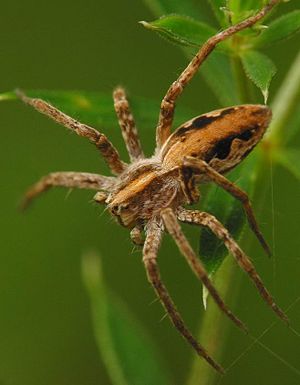Pisaura
| Pisaura | ||||||||||||
|---|---|---|---|---|---|---|---|---|---|---|---|---|

List spider ( Pisaura mirabilis ) |
||||||||||||
| Systematics | ||||||||||||
|
||||||||||||
| Scientific name | ||||||||||||
| Pisaura | ||||||||||||
| Simon , 1885 |
The genus Pisaura belongs to the Pisauridae family and, according to the current state of knowledge and the Platnick catalog, comprises 13 species. (As of April 2019)
In 1885, Eugène Simon replaced the then generic name Ocyle with Pisaura . When he founded the new family Pisauridae in his Natural History of Spiders in 1898 , he distinguished Pisaura from Dolomedes and other genera mainly on the basis of the dentition of the chelicerae and the size and arrangement of the eyes . Blandin corrected in 1976 to differentiate into the very closely related genus Afropisaura the information on the Eye-order and added characteristics of female and male Genitialen added.
Systematics
The following types of Pisaura are currently known.
- Pisaura acoreensis Wunderlich 1992 (Azores)
- Pisaura anahitiformis Kishida 1910 (Japan)
- Pisaura ancora Paik 1969 (Russia, China, Korea)
- Pisaura bicornis Zhang & Song 1992 (China, Japan)
- Pisaura bobbiliensis Reddy & Patel 1993 (India)
- Pisaura consocia ( OP-Cambridge 1872) (Israel, Lebanon, Syria)
- Pisaura decorata Patel & Reddy 1990 (India)
- Pisaura gitae Tikader 1970 (India (Sikkim), Andamans)
- Pisaura lama Bösenberg u. Strand 1906 (Russia, China, Korea, Japan)
- List spider ( Pisaura mirabilis (Clerck 1757)) (Palearctic)
- Pisaura novicia ( L. Koch 1878) (Mediterranean area to Georgia)
- Pisaura orientalis Kulczyński 1913 (Mediterranean area)
- Pisaura parangbusta Barrion & Litsinger, 1995 (Philippines)
- Pisaura podilensis Patel & Reddy 1990 (India)
- Pisaura putiana Barrion & Litsinger 1995 (Philippines)
- Pisaura quadrilineata (Lucas 1838) (Canary Islands, Madeira)
- Pisaura sublama Zhang 2000 (China)
- Pisaura swamii Patel 1987 (India)
anatomy
The front part of the body (prosoma) has a light, clearly separated longitudinal line in the middle with a very variable basic color, which ranges from light brown to mostly red-brown and gray to black. The rear part of the body (opisthosoma) is long and narrow, tapering towards the rear and provided with a broad, dark-edged zigzag band on the back. In addition, there are only three teeth on the outer chelicerene basal phalanx.
The females have a noticeably dark area ( epigyne ) with the two mating openings on the underside of the abdomen . In the males, the sexual opening in the same place is inconspicuous.
The jaws (pedipalps), the second pair of limbs, are leg-like in nymphs and females, and thickened on the foot ( eyeball ) in males . At the end of the thickening there is the penetrator ( embolus ), which stores the sperm after it has been absorbed by the sperm network until mating.
Sensory performances
Their sensory organs enable the predatory spiders to distinguish between enemies, prey and sexual partners.
Sense of sight
Species of the genus Pisaura have eight individual eyes ( ocelles ). The anterior median eyes are the main eyes, the remaining six are the secondary eyes. The latter have a light-reflecting layer ( tapetum ) that makes them shine.
With its eyes, the Pisaura overlooks almost its entire surroundings, i.e. from left to right an area of 140 °, of which 60 ° overlap. The field of view extends over 100 ° from top to bottom. The main eyes have the best resolution of less than 2 °, the secondary eyes of up to 4 °.
Sense of hearing
The species of the genus Pisaura have special hairs that sit in a cup ( trichobothria ), on the legs and pedipalps. They can register air vibrations and sounds in the prey frequency range and enable prey to be caught at night.
Cleft sense
In addition to different types of hair, there are individual cleft sensory organs ( lyre-shaped organ ) distributed over the whole body . They measure deformations of the cuticle in which they are embedded and serve as vibration receptors.
Sense of touch and smell
Touch stimuli and chemical stimuli are picked up by means of so-called chemotactile hairs on palps , legs and chelicerae in direct leg contact . The extent to which the tarsal organs , which are also used as moisture receptors, are used to perceive smells is unknown.
literature
- PM Brignoli: On the problem of the Mediterranean Pisaura species (Arachnida, Araneae, Pisauridae) . Zool. Number 213, 1984
- Rainar Nitzsche: The spider with the bride present. Pisaura mirabilis (Clerck, 1757) (Pisauridae) and the mating behavior of related species of the family Pisauridae. Nitzsche, 1999, 2007
Web links
Pisaura in the World Spider Catalog